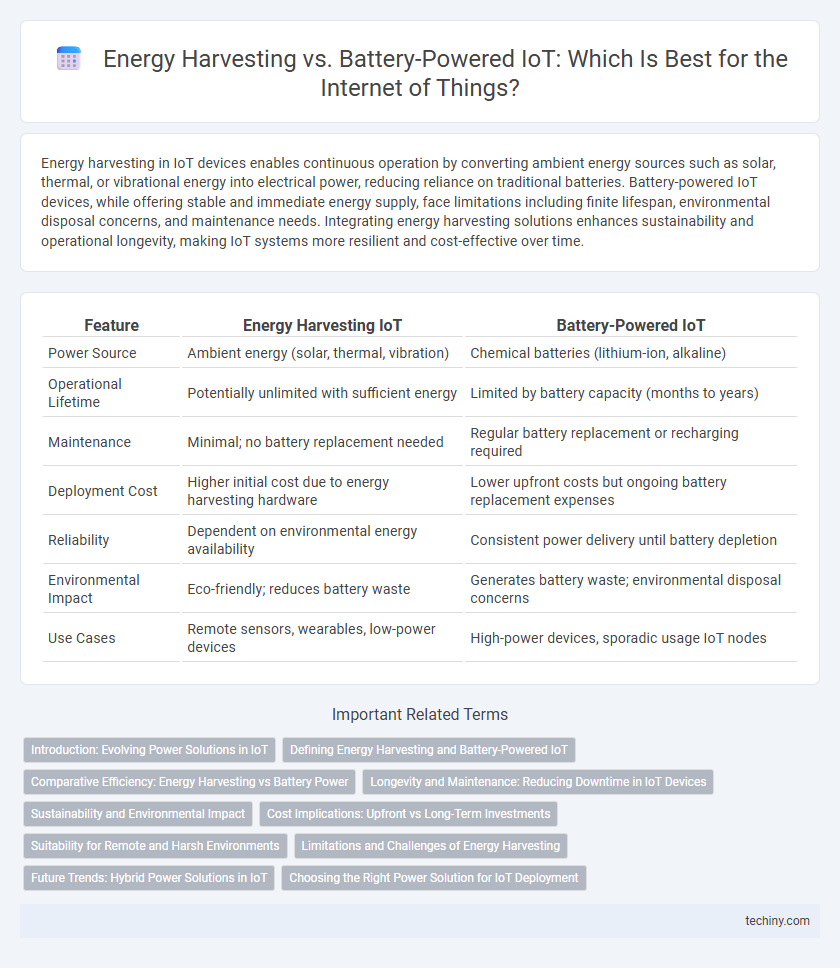Energy harvesting in IoT devices enables continuous operation by converting ambient energy sources such as solar, thermal, or vibrational energy into electrical power, reducing reliance on traditional batteries. Battery-powered IoT devices, while offering stable and immediate energy supply, face limitations including finite lifespan, environmental disposal concerns, and maintenance needs. Integrating energy harvesting solutions enhances sustainability and operational longevity, making IoT systems more resilient and cost-effective over time.
Table of Comparison
| Feature | Energy Harvesting IoT | Battery-Powered IoT |
|---|---|---|
| Power Source | Ambient energy (solar, thermal, vibration) | Chemical batteries (lithium-ion, alkaline) |
| Operational Lifetime | Potentially unlimited with sufficient energy | Limited by battery capacity (months to years) |
| Maintenance | Minimal; no battery replacement needed | Regular battery replacement or recharging required |
| Deployment Cost | Higher initial cost due to energy harvesting hardware | Lower upfront costs but ongoing battery replacement expenses |
| Reliability | Dependent on environmental energy availability | Consistent power delivery until battery depletion |
| Environmental Impact | Eco-friendly; reduces battery waste | Generates battery waste; environmental disposal concerns |
| Use Cases | Remote sensors, wearables, low-power devices | High-power devices, sporadic usage IoT nodes |
Introduction: Evolving Power Solutions in IoT
Energy harvesting technologies capture ambient energy from sources like solar, thermal, and vibration, enabling self-sustaining IoT devices with extended operational lifespans. Battery-powered IoT relies on finite energy storage, necessitating regular maintenance or replacements, which can increase operational costs and downtime. Advancements in energy harvesting improve device autonomy and scalability, driving innovation in sustainable IoT deployments.
Defining Energy Harvesting and Battery-Powered IoT
Energy harvesting in IoT refers to the process of capturing and converting ambient energy sources such as solar, thermal, or vibrational energy into electrical power to sustain device operations without external charging. Battery-powered IoT devices rely on stored chemical energy within rechargeable or disposable batteries, providing consistent power but requiring periodic maintenance or replacement. Understanding these power sources is crucial for optimizing IoT device longevity, efficiency, and deployment in remote or inaccessible environments.
Comparative Efficiency: Energy Harvesting vs Battery Power
Energy harvesting IoT devices leverage ambient sources like solar, thermal, and kinetic energy to enable sustainable, maintenance-free operation, whereas battery-powered devices offer consistent performance but require periodic replacement or recharging. Energy harvesting systems excel in low-power, long-lifespan applications by minimizing downtime and environmental impact through continuous energy replenishment. Battery-powered IoT solutions provide higher energy density and reliability for intensive tasks but face challenges in scalability and ecological footprint due to limited battery life and disposal issues.
Longevity and Maintenance: Reducing Downtime in IoT Devices
Energy harvesting IoT devices offer superior longevity by continuously generating power from ambient sources such as solar, thermal, or kinetic energy, significantly reducing the need for battery replacements and maintenance interventions. In contrast, battery-powered IoT devices face limited operational lifespan dictated by battery capacity, leading to frequent downtime due to battery depletion and replacement cycles. Leveraging energy harvesting technologies can minimize maintenance costs and improve overall system reliability, ensuring sustained performance in remote or hard-to-access environments.
Sustainability and Environmental Impact
Energy harvesting IoT devices utilize renewable sources such as solar, thermal, or vibrational energy, significantly reducing reliance on finite battery resources and minimizing electronic waste. Battery-powered IoT systems contribute to environmental degradation through frequent battery replacements and disposal challenges, leading to increased pollution and resource consumption. Sustainable IoT deployment favors energy harvesting methods to extend device lifespans, lower carbon footprints, and support circular economy principles in technology ecosystems.
Cost Implications: Upfront vs Long-Term Investments
Energy harvesting IoT devices often require higher upfront investments due to the integration of energy capture components like solar panels or piezoelectric materials, but they significantly reduce long-term operational costs by minimizing battery replacements and maintenance. Battery-powered IoT devices usually have lower initial costs; however, they incur recurring expenses related to battery procurement, disposal, and device downtime for charging or replacement. Evaluating total cost of ownership reveals that energy harvesting solutions offer better financial sustainability in large-scale or remote deployments.
Suitability for Remote and Harsh Environments
Energy harvesting IoT devices excel in remote and harsh environments by utilizing ambient energy sources such as solar, thermal, or vibration, eliminating the need for frequent battery replacements and reducing maintenance costs. Battery-powered IoT solutions often face limitations in these conditions due to battery degradation, limited lifespan, and environmental sensitivity, leading to potential system failures or downtime. Deploying energy harvesting technology ensures sustainable operation, particularly in inaccessible locations where consistent power supply and device longevity are critical.
Limitations and Challenges of Energy Harvesting
Energy harvesting in IoT faces significant limitations such as inconsistent energy supply due to environmental variability, restricting device reliability and continuous operation. Low power density and energy conversion inefficiencies challenge the ability to support high-demand applications, often necessitating supplemental power sources. Furthermore, the integration of energy harvesting systems increases design complexity and upfront costs, posing adoption barriers for widespread IoT deployment.
Future Trends: Hybrid Power Solutions in IoT
Hybrid power solutions in IoT combine energy harvesting technologies such as solar, thermal, and piezoelectric sources with traditional battery power to enhance device longevity and reliability. These systems optimize power management by dynamically switching between harvested energy and stored battery reserves, reducing downtime and maintenance costs. Emerging trends emphasize scalable, adaptive hybrid designs tailored for diverse IoT applications in smart cities, industrial automation, and environmental monitoring.
Choosing the Right Power Solution for IoT Deployment
Energy harvesting IoT devices leverage ambient energy sources such as solar, thermal, or vibration to enable maintenance-free, long-term operation, ideal for remote or hard-to-access locations. Battery-powered IoT solutions offer higher reliability and consistent power output, suitable for applications demanding continuous connectivity and data transmission. Selecting the right power solution depends on factors like device energy consumption, deployment environment, maintenance capabilities, and expected operational lifespan.
Energy harvesting vs Battery-powered IoT Infographic

 techiny.com
techiny.com